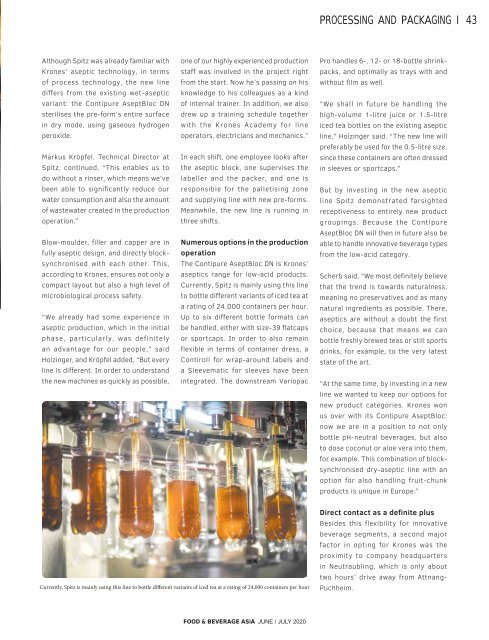Food & Beverage Asia June/July 2020
Food & Beverage Asia (FBA) is the leading source of food and beverage news in Asia since 2002. FBA delivers a comprehensive view of the food and beverage landscape, spanning across the latest health and nutrition trends and industry innovations in ingredients, recipe formulations, food science, sustainability, packaging, and automation, as well as advancements in agri and food-tech.
Food & Beverage Asia (FBA) is the leading source of food and beverage news in Asia since 2002. FBA delivers a comprehensive view of the food and beverage landscape, spanning across the latest health and nutrition trends and industry innovations in ingredients, recipe formulations, food science, sustainability, packaging, and automation, as well as advancements in agri and food-tech.
You also want an ePaper? Increase the reach of your titles
YUMPU automatically turns print PDFs into web optimized ePapers that Google loves.
PROCESSING AND PACKAGING<br />
43<br />
Although Spitz was already familiar with<br />
Krones’ aseptic technology, in terms<br />
of process technology, the new line<br />
differs from the existing wet-aseptic<br />
variant: the Contipure AseptBloc DN<br />
sterilises the pre-form’s entire surface<br />
in dry mode, using gaseous hydrogen<br />
peroxide.<br />
Markus Kröpfel, Technical Director at<br />
Spitz, continued, “This enables us to<br />
do without a rinser, which means we’ve<br />
been able to significantly reduce our<br />
water consumption and also the amount<br />
of wastewater created in the production<br />
operation.”<br />
Blow-moulder, filler and capper are in<br />
fully aseptic design, and directly blocksynchronised<br />
with each other. This,<br />
according to Krones, ensures not only a<br />
compact layout but also a high level of<br />
microbiological process safety.<br />
“We already had some experience in<br />
aseptic production, which in the initial<br />
phase, particularly, was definitely<br />
an advantage for our people,” said<br />
Holzinger, and Kröpfel added, “But every<br />
line is different. In order to understand<br />
the new machines as quickly as possible,<br />
one of our highly experienced production<br />
staff was involved in the project right<br />
from the start. Now he’s passing on his<br />
knowledge to his colleagues as a kind<br />
of internal trainer. In addition, we also<br />
drew up a training schedule together<br />
with the Krones Academy for line<br />
operators, electricians and mechanics.”<br />
In each shift, one employee looks after<br />
the aseptic block, one supervises the<br />
labeller and the packer, and one is<br />
responsible for the palletising zone<br />
and supplying line with new pre-forms.<br />
Meanwhile, the new line is running in<br />
three shifts.<br />
Numerous options in the production<br />
operation<br />
The Contipure AseptBloc DN is Krones’<br />
aseptics range for low-acid products.<br />
Currently, Spitz is mainly using this line<br />
to bottle different variants of iced tea at<br />
a rating of 24,000 containers per hour.<br />
Up to six different bottle formats can<br />
be handled, either with size-39 flatcaps<br />
or sportcaps. In order to also remain<br />
flexible in terms of container dress, a<br />
Contiroll for wrap-around labels and<br />
a Sleevematic for sleeves have been<br />
integrated. The downstream Variopac<br />
Pro handles 6-, 12- or 18-bottle shrinkpacks,<br />
and optimally as trays with and<br />
without film as well.<br />
“We shall in future be handling the<br />
high-volume 1-litre juice or 1.5-litre<br />
iced tea bottles on the existing aseptic<br />
line,” Holzinger said. “The new line will<br />
preferably be used for the 0.5-litre size,<br />
since these containers are often dressed<br />
in sleeves or sportcaps.”<br />
But by investing in the new aseptic<br />
line Spitz demonstrated farsighted<br />
receptiveness to entirely new product<br />
groupings. Because the Contipure<br />
AseptBloc DN will then in future also be<br />
able to handle innovative beverage types<br />
from the low-acid category.<br />
Scherb said, “We most definitely believe<br />
that the trend is towards naturalness,<br />
meaning no preservatives and as many<br />
natural ingredients as possible. There,<br />
aseptics are without a doubt the first<br />
choice, because that means we can<br />
bottle freshly brewed teas or still sports<br />
drinks, for example, to the very latest<br />
state of the art.<br />
“At the same time, by investing in a new<br />
line we wanted to keep our options for<br />
new product categories. Krones won<br />
us over with its Contipure AseptBloc:<br />
now we are in a position to not only<br />
bottle pH-neutral beverages, but also<br />
to dose coconut or aloe vera into them,<br />
for example. This combination of blocksynchronised<br />
dry-aseptic line with an<br />
option for also handling fruit-chunk<br />
products is unique in Europe.”<br />
Currently, Spitz is mainly using this line to bottle different variants of iced tea at a rating of 24,000 containers per hour<br />
Direct contact as a definite plus<br />
Besides this flexibility for innovative<br />
beverage segments, a second major<br />
factor in opting for Krones was the<br />
proximity to company headquarters<br />
in Neutraubling, which is only about<br />
two hours’ drive away from Attnang-<br />
Puchheim.<br />
FOOD & BEVERAGE ASIA JUNE / JULY <strong>2020</strong>


















